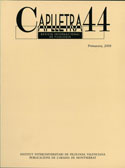Posició i funció dels connectors «a més (a més)», «però» i «doncs» en català escrit i oral
DOI:
https://doi.org/10.7203/caplletra.44.4805Palabras clave:
Connectors, Oral Language, Distribution Resumen
Resumen
This article is an approach to the study of the syntactic positions that parentetic connectors take in oral discourse in Catalan –in sentential segments particularly– based on the analysis of three connectors with different meanings: «a més a més» (additive), «però» (contrastive) and «doncs» (consecutive). The methodology used is contrastive: firstly, the positions in which all three linking words stand in a corpus of written language (written press) are studied, and secondly, the results obtained are
compared with datum coming from an oral corpus constituted mainly of monologic texts. The comparison brings to light that conditions of production of oral modality (immediateness, lack of planning, etc) force to resorting to own strategies to guarantee
the connection of the text, like reinforcing a conjunction with a parentetic connector («a més a més»), to promote the conjunctive use of a connector («però») and to assure the connection among subject-rheme («doncs»)
 Descargas
Descargas
Descargas
Publicado
Cómo citar
-
Resumen565
-
PDF (Català)125
Número
Sección
Licencia
El autor o autora que dirija un trabajo a la redacción de Caplletra para ser publicado tiene que ser la persona titular legítima de los derechos de explotación. La legitimación para la publicación del trabajo tiene que incluir también las imágenes, las tablas, los gráficos y otros materiales que puedan complementar el texto, con independencia de si es su autor o autora.
Copyright. Al publicar el trabajo en la revista, el autor o autora cede a Caplletra. Revista Internacional de Filologia los derechos de explotación (reproducción, distribución y comunicación pública), tanto para la edición impresa en papel como para la versión electrónica.
Todos los trabajos publicados en Caplletra se encuentran bajo una licencia Creative Commons del tipo Reconocimiento-NoComercial-SinObraDerivada 4.0.
RESPONSABILIDAD
Caplletra. Revista Internacional de Filologia no se identifica necesariamente con los puntos de vista sostenidos en los trabajos que publica.Caplletra. Revista Internacional de Filologia declina toda responsabilidad derivada de cualquier vulneración eventual de los derechos de propiedad intelectual que pudiera ser llevada a cabo por los autores o autoras.






